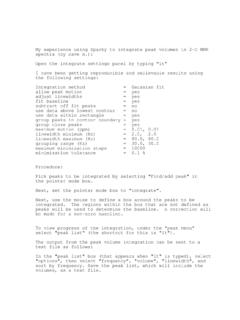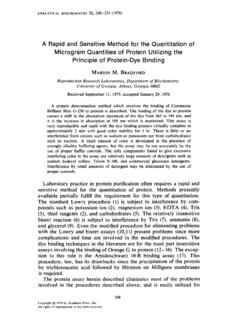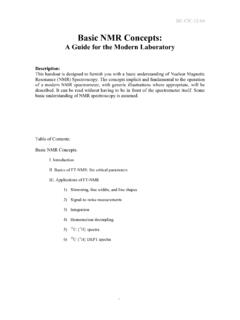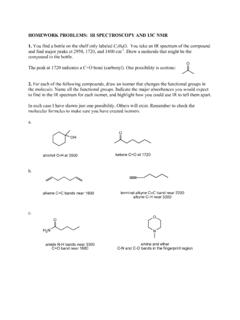Transcription of Identifying amino acids in protein NMR spectra
1 Identifying amino acids in protein nmr spectra :1) Glycine (Gly, G)Glycine is the only amino acid with 2 alpha protons (H 1 and 2).Often the HN-H coupling is observed for both alpha protons, alongthe same amide H line of the COSY or TOCSY spectrum. The H 1 toH 2 coupling is usually quite strong, and can be seen in COSY orTOCSY spectrum. Sometimes the two alpha protons have equal ornearly equal chemical shifts, so the H 1 to H 2 coupling may notbe careful not to confuse glycine with threonine: Note that H andH of threonine have similar to H 1 and H 2 of 15N amide nitrogen chemical shift is usually in the range of104 to 115 ppm, slightly lower than the amide 15N chemical shift ofother amino acid 13C alpha carbon chemical shift is usually in the range of 43to 47 ppm, slightly lower than the 13C alpha carbon chemical shiftof other amino acid ) Alanine (Ala, A)
2 Look for the strong methyl to H coupling in COSY or from amide proton to methyl group is usually observed 13C alpha carbon chemical shift is usually in the range of 50to 53 ppm, slightly lower than the 13C alpha carbon chemical shiftof other amino acid types (except glycine).The 13C beta carbon chemical shift is usually near 20 ppm, slightlylower 13C beta carbon chemical shift of other amino acid ) Valine (Val, V)Look for 2 methyl groups coupled to the same beta proton, in COSYor from H to both methyl groups is usually observed from amide proton to both methyl groups is sometimesobserved in ) Serine (Ser, S)Chemical shifts of the two H are distinctive, near ppm (butdon't confuse with Cys, which has two H near ppm).
3 5) Threonine (Thr, T)Threonine is unique in that H and H are both usually between 4and 5 ppm. Sometimes the chemical shift of H is greater than H .Look for strong H to H peak in TOCSY and COSY (near alanine Ha toHb). Unlike alanine, threonine usually has strong H to H peak to H peak in COSY and TOCSY can usually be seen near thediagonal, between 4 and 5 ppm).6) Cysteine (Cys, C)Chemical shifts of the two H are distinctive, near ppm (butdon't confuse with Cys, which has two H near ppm).7,8) Aspartic acid (Asp, D) and Asparagine (Asn, N)Chemical shifts of the two H are distinctive, near ppm (butsimilar to H of Phe, His, Tyr, Trp).
4 In Asn and Gln, there is often a TOCSY peak between the two amineprotons (near to ppm).In Asn and Gln, there are often NOE peaks between the two amineprotons (near to ppm) and the two H near ) Glutamic acid (Glu,E), Glutamine (Gln,Q), Methionine (Met,M)These three amino acid types are distinctive in that the two H chemical shifts are greater than the two H chemical shifts (H near ppm, H near ppm).In Gln and Asn, there is often a TOCSY peak between the two amineprotons (near to ppm).In Gln and Asn, there are often NOE peaks between the two amineprotons (near to ppm) and the two H near methionine methyl group is usually a sharp singlet line near 2ppm, with no through bond coupling to any other ) Isoleucine (Ile, I)The four-bond coupling between H and gamma methyl group isusually observed as a strong peak in from amide proton to gamma methyl group is usuallyobserved in ) Leucine (Leu, L)Look for 2 methyl groups coupled to the same H , in COSY or TOCSY(be careful not to confuse with valine).
5 Coupling from H to both methyl groups is usually observed inTOCSY (be careful not to confuse with valine).Coupling from amide proton to both methyl groups is sometimesobserved in TOCSY (be careful not to confuse with valine).14,15) Lysine (Lys, K) and Arginine (Arg, R)Lys and Arg are difficult to distinguish since each has two H near ppm and two H near arginine, the side chain amide proton is often observed ppm, and coupling from side chain amide to H and H is side chain amine of Lys is often not observed, or is often abroad (often overlapping) peaks in COSY and TOCSY near to are lysine H to H .Strong (often overlapping) peaks in COSY and TOCSY near to are Arg H to H.
6 16) Proline (Pro, P)The H to H couplings appears in a relatively sparse region of theCOSY and TOCSY spectrum, near to ppm).NOE peaks from H to amide HN of the next amino acid in thesequence are often ) Tryptophan (Trp, W)The four protons on the ring farthest from the protein backbone(chemical shifts usually between and ppm) are coupledthrough TOCSY peaks (for 3, 4 and 5-bond couplings) and COSY peaks(for 3-bond couplings). In TOCSY, 3-bond coupling is usuallystronger than 4-bond and 5-bond coupling, though all are ring HN proton of tryptophan has a chemical shift near 10 is usually a strong NOE peak from the ring HN proton to thenearest C-H proton on the same 5-member is usually a strong NOE peak from the ring HN proton to thenearest C-H proton on the 6-member is sometimes a TOCSY peak from the ring HN proton to thenearest C-H proton on the same 5-member is no TOCSY or COSY peak connecting H to the ring are usually strong NOE peaks from the two H protons to theC-H proton on the 5-member ) Tyrosine (Tyr, Y)
7 There are usually 2 unique proton chemical shifts on the tyrosinering (H and H ) near 7 ppm. H 1 and H 2 usually have equivalentchemical shifts, as do H 1 and H two H usually have strong NOE peaks to the ring protonnearest the H .There is no TOCSY or COSY peak connecting H to the ring ) Phenylalanine (Phe, F)There are usually 3 unique proton chemical shifts on the Phe ring(H and H and H ) near to ppm. H 1 and H 2 usually haveequivalent chemical shifts, as do H 1 and H two H usually have strong NOE peaks to the ring protonnearest the H .There is no TOCSY or COSY peak connecting H to the ring ) Histidine (His, H)The two C-H ring protons usually have chemical shifts between ppm, with the ring proton nearest the H having the lowerchemical two H usually have strong NOE peaks to the ring protonnearest the H.
8 Chemical shifts of histidine ring protons are usually quite pHdependent, due to the pKa of one of the ring N-H protons beingnear Chemical shifts of the two ring C-H protons usually arehigher at low pH. The histidine ring N-H protons are not two histidine ring C-H protons are usually sharp lines(singlets). Sometimes a weak TOCSY or COSY peak is observedbetween the two C-H protons of the two H usually have strong NOE peaks to the ring C-H protonnearest the H.








